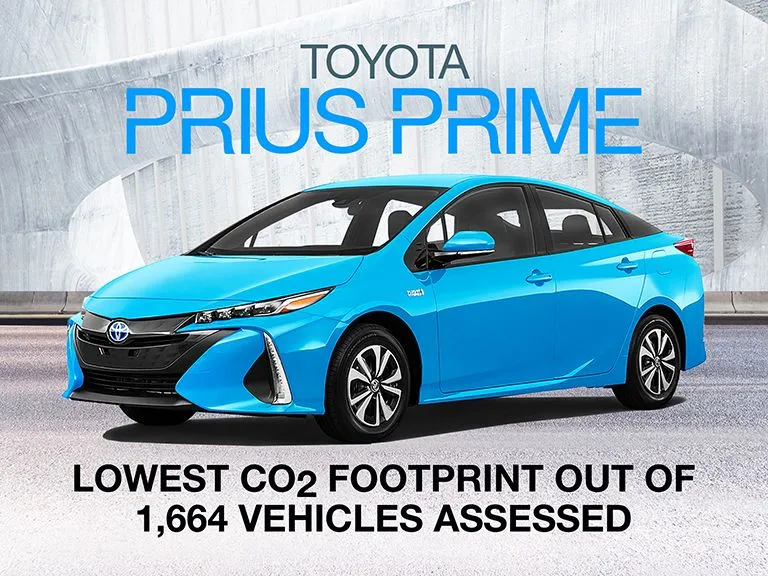
Prius Prime earns ASG's Best Environmental Performance Award for lowest C02 footprint
For 2018, the Prius Prime earned the Automotive Science Group’s BEST ENVIRONMENTAL PERFORMANCE Award for its 133-MPGe EPA rating, its 25-mile electric range, low manufacturing footprint, usage of biodegradable upholstery and dashboard materials, and end-of-life recyclability. ASG’s annual study found the Prime to hold the smallest carbon footprint of any model year 2018 car in the North American market. In ASG’s data-driven automotive life-cycle assessment, the Prius Prime not only won its class, but also outperformed all 1,664 (with trim variants) vehicles assessed.
In ASG’s all-around performance assessment – the combined environmental, social and economic performance analysis – the Prius Prime furthered its winnings to earn the highest distinction as ASG’s BEST ALL-AROUND PERFORMANCE CAR OF 2018. The PHEV outperformed all conventional and alternatively powered vehicles to take the top honor.
Toyota calls its Prius Prime the company’s most advanced hybrid yet. With an EPA-estimated 133 MPGe and 54 combined mpg it’s one of the most efficient cars in its class and one of the most efficient hybrids in America. In 2018, it was the best-selling plug-in hybrid in the USA. These days, the Prime represents 35% of the total Prius family sales. It was the second best-selling EV in the USA in 2018, with sales of 27,595 units, beat out only by the Tesla Model 3.
Prime’s cutting-edge, lightweight materials, advanced technology, total range of 640 gas and electric miles and affordability make it one of the most desirable plug-ins on the market. The hybrid can drive up to 25 miles in EV Mode, which uses its 8.8kWh battery for power.
The California Air Resources Board has given Prime a Low Emission Vehicle (LEV) III, Super Ultra Low Emission Vehicle (SULEV) 30 Rating. A SULEV is a super-ultra-low-emission vehicle: SULEV emissions are 90% cleaner than the average new model year car.
When the Prius was first launched in the U.S. market in 2000, the world’s first mass-produced hybrid boasted of its 41 MPG combined (city/hwy). With a 117.5 lb. NI-MH battery pack and a curb weight of 2765 lbs., Toyota lead the industry into the hybrid era with this compact model. 18 years later, the Prius Two Eco is equipped with a lighter lithium Ion battery that achieves 56 MPG combined – a notable 15 MPG improvement.
To see what this improvement means in CO2 terms, ASG conducted a comparative life-cycle assessment, and found the 2000 Prius to hold 295 grams of CO2-e emissions per mile driven life-time (attributing CO2 emissions from raw material extraction, processing and manufacturing, through vehicle use with fuel inputs, to vehicle end-of-life). ASG found the 2018 Prius Eco to hold 226 grams of CO2-e emissions per mile driven life-time, a 23% reduction over the 2000 model and a significant stride without a full technology leap.
While this is notable, the model that places the Prius at the top of ASG’s 2018 API, is the Prius Prime. Toyota is bridging the technological gap once again and leading us into the battery electric era with this plug-in hybrid model, featuring 133 MPG-e and a 25-mile all-electric capability. According to ASG, this lithium-ion plug-in hybrid model holds 181 grams of CO2-e emissions per mile driven life-time, a life-cycle carbon footprint that is 39% less than the first generation Prius.
www.automotivescience.com/products/2018-toyota-prius-prime
Recent Posts
- The 2022 Audi Q4 e-Tron SUV combines performance, practicality and luxury
- Ford's 2022 F150 Lightning All-Electric Truck is in high demand
- Legendary Audi performance is at the heart of the 2022 Audi e-tron GT and its RS sibling.
- Meet the Lexus RZ 450e – the luxury brand’s 1st EV
- The 2022 GV60 is Genesis’ first all-electric vehicle

